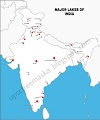Geosynchronous Orbit
- A geosynchronous orbit is a high Earth orbit that allows satellites to match Earth's rotation.
- Located at 22,236 miles (35,786 kilometers) above Earth's equator, this position is a valuable spot for monitoring weather, communications and surveillance.
- Because the satellite orbits at the same speed that the Earth is turning, the satellite seems to stay in place over a single longitude, though it may drift north to south.
Features of geosynchronous orbit:
- It is a non-circular orbit.
- Unlike GEO orbit which can only be one, there are many geosynchronous orbits.
- Inclined orbit i.e orbit is not in an equatorial plane.
- The angular velocity and Period of revolution of the satellite is same that of the earth.
What is Inclined orbit ?
- An inclined orbit is used to cover the Polar Regions.
- It’s not a very popular orbit and used not very frequently.
- The height of the inclined orbit is kept such that it covers the required area of the region of interest.
- The time for which the satellite is visible to the point on the earth is also controlled.
- Satellite cannot remain in continuous contact with the point on the earth if rotating in an inclined orbit.
- Sometimes the inclined orbit is also called elliptical inclined orbit.
Difference between the Geostationary and Geosynchronous Orbits:
Sometimes a satellite in the space has a period of revolution equal to the period of rotation of the earth, but its orbit is neither equilateral nor Circular.
So, this satellite will finish one revolution around the earth in exactly one day i.e. 23 hours, 56 Minutes and 4.1 seconds, yet it does NOT appear stationary from the earth.
It looks oscillating but not stationary and that is why it is called Geosynchronous.






0 Comments
Feel free to ask any doubt in comment section